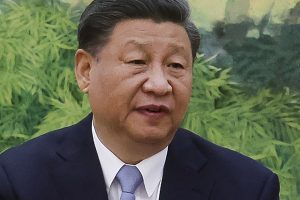A possibly more aggressive policy toward Okinawa by China has been attracting attention in East Asia recently. The perception stems from an express reference made by Chinese President Xi Jinping to Japan’s southernmost islands, known as the Ryukyu, in early June during a visit to the China National Archives of Publications and Culture (CNAPC) and the Chinese Academy of History, a repository of Chinese classical books. It is rare for a Chinese president to make such a reference, giving rise to speculation that an underlying motive may be at play: a visit to China earlier this month by Denny Tamaki, governor of Okinawa Prefecture as part of a delegation from Japan.
Xi Jinping’s comment was made during his tour of the CNAPC, when he stopped in front of an exhibit and listened to the curator’s explanation. It even warranted a mention in the People’s Daily. The comment came in response to the curator’s explanation about the “Records of the Imperial Title-conferring Envoys to Ryukyu” of the Ming Dynasty. This book describes the envoys dispatched by the Ming Dynasty to Ryukyu to convey Ryukyu’s position as a tributary state of the Ming Dynasty. The work is widely known in China as it is believed to be the oldest record showing that the Senkaku Islands (known in China as the Diaoyu Islands) are Chinese territory. (In Japan, the passage in question is not considered to constitute proof of this.)
When the curator mentioned the passage relating to the Senkaku/Diaoyu Islands, Xi remarked: “When I was working in Fuzhou, I knew that Fuzhou had a Ryukyu Museum and a Ryukyu tomb, and that Fuzhou had a deep relationship with Ryukyu, and that the 36 clans of Fujian went over to the Ryukyu Islands and settled there.” The Ryukyu Museum commemorates the envoys who came to China from Ryukyu to pay tribute to the Ming dynasty, and the Ryukyu tomb is the resting place of the Ryukyu people who died in Fuzhou. The 36 clans of Fujian, also referred to as the 36 clans of Kume, came to Ryukyu and oversaw its commitment to pay tribute to the Ming Dynasty.
Xi’s comment may have been sparked by memories of the more than 15 years he spent working in Fujian province. However, Xi immediately went on to emphasize the “need to collect and sort classical books and woodblock-printed books to ensure the legacy and continued development of Chinese civilization.” This gave rise to widespread speculation, since it could be interpreted to mean that the relationship with Okinawa is part of Chinese civilization.
Xi’s remark was welcomed by Okinawa Prefecture Governor Denny Tamaki, who commended Xi for his understanding of Okinawa.
The People’s Republic of China acknowledges that Okinawa is Japanese territory. This position is also supported by the fact that Okinawa Prefecture is included within the jurisdiction of the Fukuoka Consulate general of the PRC. Indeed, it is the Republic of China government in Taiwan that would seem not to acknowledge the fact that Okinawa Prefecture is Japanese territory. However, questions over the status of Okinawa have arisen frequently. In the 2010s, for instance, the People’s Daily published an article by a “scholar” who raised questions about whether Okinawa belonged to China. China’s official stance is not that regions which once paid tribute to China are Chinese territory. It does, however, express doubt about Okinawa’s status as part of Japan.
Arguments put forward by “scholars” in media outlets such as the People’s Daily are one thing. Comments by Xi Jinping carry a different weight entirely. Xi’s latest remark will fuel more controversy over the “Ryukyu” issue in China, and if it becomes something like the Senkaku Islands issue, it will present a new challenge for China-Japan relations.
On the other hand, surveys such as the Attitude Survey of Okinawa Prefectural Residents Toward China conducted by Okinawa Prefecture in the 2010s show that the residents of Okinawa Prefecture have an extremely unfavorable attitude toward China. While interest in Okinawa may be increasing in China, it is unclear whether interest in China will similarly increase in Okinawa.

































